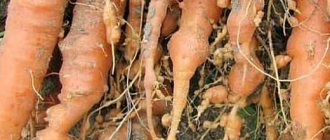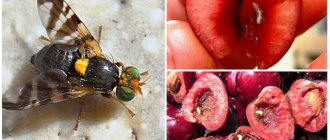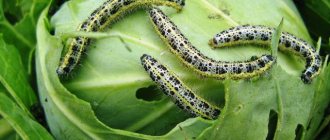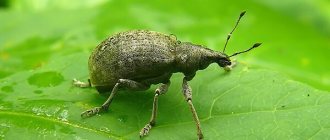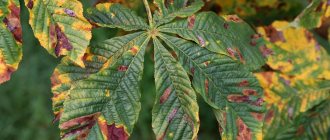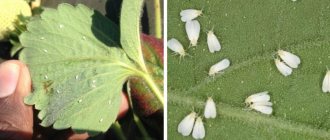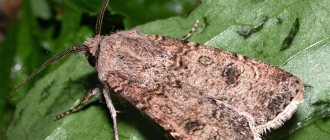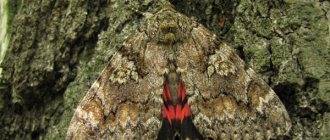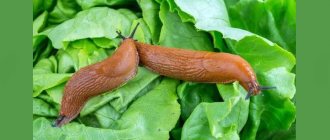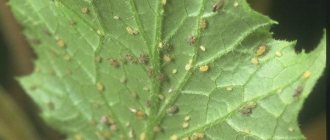Of course, mines in this case are not ammunition. We are talking about special damage to plants caused by insects. The name is associated with the ancient meaning of the word “mine” - a tunnel, a hidden passage. Many insects live inside leaves, needles, stems, and young shoots and make passages, or “mines,” in them. And they are called, frighteningly, “miners.” They live very secretly, and the result of their activities becomes noticeable too late.
- What is the danger of miners?
- The secretive lifestyle of mining insects
- Laying a mine: how does it happen?
- How to find a mine? 7 Signs of Miners
Plant protection from leaf miners
One of the serious types of damage to the leaf apparatus of plants is the damage caused by the larvae of leaf miners and leaf miners.
The females of these pests are armed with a proboscis, with which they pierce plant tissue to suck out food or lay eggs. The pests themselves are yellowish-white or brownish larvae 2-3 mm long. These larvae gnaw out typical mined tunnels in the leaves for several days, and then they pupate inside the leaves or on their surface.
Honeysuckle affected by leaf miner. © Krzysztof Ziarnek
The pupal stage lasts from 8 to 14 days, then it hatches into an adult insect. In total, the development of an adult insect from an egg takes only three weeks.
Female miners, by piercing the epidermis of the leaf, are capable of transmitting pathogens of plant diseases, for example, mosaic viruses of soybean, tobacco, celery and watermelon.
Laying a mine: how does it happen?
The mine is always eaten by a larva, but first an adult insect must fly to the plant and lay an egg. Do small insects swarm around your plants, do they “cover” the trunks? This may well be a massive outbreak of one or more types of miners. If a butterfly, beetle, fly or sawfly crawls along a leaf, stops, and then a whitish, yellowish or milky-green bubble remains in this place, egg laying is in full swing.
tomato leaf damaged by miners
The larvae of many leaf miners do not come to the surface of the leaf, but bite into it directly through the egg wall. The mine turns out to be completely closed - its entrance hole is hidden by the shell of the egg. After a week, it overgrows, and the larva becomes completely isolated from the outside world.
Symptoms of plant damage by leaf miners
Depending on the type of miner, the passages gnawed by the larvae can be found on the underside or upper side of the leaves. Most species specialize in certain plants, while others mine a wide variety of plants. They attack ornamental plants, vegetables and shrubs.
The first sign of damage is small pits on the leaves - puncture marks left by females.
Caterpillar of a leaf miner in a double-sided spotted mine (Cameraria ohridella). © Georg Slickers
The secretive lifestyle of mining insects
Mining insects are protected by plant tissues and are not afraid of airborne pollutants. The evaporation of water from the surface of the leaves protects the leaf miner from extremely high temperatures, and the good thermal conductivity of the tissues protects it from extremely low temperatures.
These pests relatively rarely die from attacks by predators and parasites, and the isolation of their larvae prevents the spread of disease. Therefore, on any plant - from plantain to two-hundred-year-old larch - at least one species of miners lives. They are found among beetles, dipterans and hymenoptera, but the vast majority of miners are butterflies.
mining insects
Methods for combating leaf miners
Methods for controlling leafmining flies and moths at different stages of development of these insects vary.
Eggs are destroyed using paraffin-containing products. The larvae have many natural enemies. These are primarily parasites that lay their eggs in the larvae of leaf miners. However, they can only be used accurately and purposefully in greenhouses. Repeated spraying of plants with products containing pyrethrum is also effective.
The adult (final stage of development) of miners can be caught using sticky boards or products containing pyrethrum. It should be remembered that miners quickly become resistant to all pesticides.
Attention! Pyrethrum-based insecticides are very harmful to health. When working with them, wear gloves and face masks! Spray either in the morning or evening, when biological enemies such as ladybugs or ichneumon wasps are not active. Stay away from bodies of water.
Chestnut leaf affected by leaf miner. © Georg Slickers
Natural methods of struggle
Remove affected leaves. Check the plants for gnawed passages and puncture marks. Cut off and destroy leaves.
Cover with non-woven cloth. Grow vegetables and flowers under non-woven fabric to prevent leaf miners from laying their eggs on them.
Spray with spring oil. Oil can only be used on plants with strong leaves.
Let riders into the greenhouse. You can purchase them at specialized gardening stores.
Control methods using insecticides
If a leafminer fly or moth is detected, insecticides should not be applied immediately. Use them only in case of particularly severe damage. Spray products containing pyrethrum are effective. However, spraying will have to be done several times in a row. Spray five to six times at three to five day intervals.
Flies and moths die after one single spraying. However, their larvae are more resilient. Insecticides often have no effect on pupae at all because in some species the pupation phase occurs in the ground. With very severe lesions, watering the soil with products containing pyrethrum brings some success.
Prevention of nightshade miner
It is almost impossible to prevent the appearance and reproduction of the pest. All you can do is:
- monitor the condition of the plants as often as possible;
- treat the seed material and soil in which the tomatoes will be planted with insecticides;
- remove weeds from the garden bed in a timely manner to attract less insects;
- Spray with an insecticide for prevention. Use biological products to reduce harm to beneficial insects and the environment.
Whatever drug is chosen to destroy the miner, remember safety precautions. Be sure to wear a respirator and latex gloves. Do not treat tomatoes with chemicals more than three times per season.
Affected plants
Fruit trees:
- Cherry, Pear - Symptoms: leaf miners and moths leave behind gnawed passages on the leaves ranging from light beige to brown. Help: remove affected leaves; Hang yellow boards to catch miners.
- Apple tree - Symptoms: mining flies and moths leave behind gnawed passages of a serpentine, round and vesicular shape. Help: remove affected leaves; Hang yellow boards to catch miners.
Traces of leaf miner damage on a tomato
Shrubs:
- Rhododendron - Symptoms: traces of leaf wear by yellowish-green azalea moth caterpillars, reaching 1 cm in length. Help: remove affected leaves; spray with pyrethrum; hang yellow plaques.
- Holly holly - Symptoms: Leafmining flies leave puncture marks in leaves; mined passages left by larvae. Help: remove affected leaves; spray with spring oil; hang yellow plaques.
- Rose - Symptoms: light spots from piercings and winding gnawed passages left in the leaves by pink leaf miners. Help: remove affected leaves regularly; spray with pyrethrum; hang yellow plaques.
Article on the topic: Family of Lily plants: list, description, genera and species
Flowers :
- Zinnia - Symptoms: Leafmining flies leave light beige, chewed-out tunnels or spots on the leaves.
- Chrysanthemum - Symptoms: leaf miner flies leave light, highly convoluted, gnawed passages in the leaves.
- Violets - Symptoms: whitish dots and gnawed out passages appear on the leaves.
Help: regularly remove affected leaves and spray with a preparation containing pyrethrum.
Serpentine caterpillar mine. © dhobern
Vegetables:
- Lettuce - Symptoms: whitish dots from punctures and gnawed out passages appear on the leaves, caused by damage from leafmining flies.
- Tomato - Symptoms: whitish dots and gnawed out passages appear on the leaves.
- Cucumber - Symptoms: white dots from punctures and tunnel-like marks of gnawing by leafmining flies appear on the leaves.
Help: let riders into the greenhouse; hang yellow plaques.
External signs of damage
It is very easy to notice the leaf miner on the leaves: punctures from the females of this parasite become the first to become obvious. Depending on the type of plant, the nature of the damage will differ, so external signs should be considered separately for specific groups.
Fruit trees
Most often, miners settle on apple, pear and cherry trees. Trees have been mined for several years and begin to dry out from the top. The mines are different shades of brown and have a snake-like or even bubbly shape. Affected leaves need to be removed; yellow boards are used to catch flies.
Flowers
Flower miners are most often found on violets, zinnias and chrysanthemums. They differ in shades and tortuosity of the lesion traces. If burrows are detected, the leaves must be urgently removed and the plant must be sprayed with a pyrethrum-based preparation.
Shrubs
Roses, rhododendron, and holly are especially at risk. Miners leave puncture points, which over time turn into long passages with many convolutions.
Vegetables
On the leaves of tomatoes, cucumbers, and lettuce, you can notice long strokes, usually of a light shade. To catch miners, you can also use yellow signs or send riders into the greenhouse. However, details about methods of combating miners in different ways are written in the final parts of the material.
Leaf miners
Spots resembling patterns are often visible on the leaves of trees, shrubs and herbaceous plants. They are called mines and are caused by insect pests that chew through passages and under the skin of leaves.
Miners damage both coniferous and deciduous trees, almost all shrubs, agricultural crops, both ornamental and medicinal plants, flowers and weeds.
Among the trees are, for example, horse chestnut, linden, holly, plane tree, robinia, rowan, thuja, apple tree ; among the shrubs - privet, rose, mackerel, hawthorn, honeysuckle, spirea ; Among the herbaceous plants are goldenrod, impatiens, strawberries, clover, clematis, sedum, spurge, bellflower, centaury, dandelion, violet .
Typically, miners of one type damage a specific type of plant, which is reflected in their names - poplar moth, linden moth, nightshade miner.
EVERYTHING YOU NEED FOR THIS ARTICLE IS HERE >>>
Most miners overwinter in the pupal stage, some in the larval or adult insect (imago) stage. In the adult stage, miners overwinter in bark cracks and other shelters, for example, in buildings. In the larval stage, leaf miners overwinter on the soil surface, in sheaths on branches, in mines in fallen leaves, and in the pupal stage - in the soil, fallen leaves, and cracks in the bark.
Some species of miners always have only one generation, while the number of generations of other species depends on the temperature during their development.
Some types of leaf miners damage leaves only in the spring, others in the summer, and still others from spring to autumn. The development periods of individual generations overlap, which complicates the determination of the timing of protective measures.
Among leaf miners, representatives of lepidoptera (miner moths) and dipterans (agromysid flies), lesser-coleoptera (beetles, leaf beetles, weevils) and hymenoptera (true sawflies) predominate.
Mina is the “calling card” of miners. Each type of miner is characterized by a certain shape of the mines, their location in the leaf, and in the mines there are larvae, excrement and flight holes. Mines can be shaped like a tunnel, a spot, or a tunnel with a spot at the end.
The harmfulness of miners is manifested in a decrease in the viability of plants, their decorativeness, growth rates, intensity of fruiting and deterioration in the quality of seeds. The harmfulness of miners increases in areas where one or more closely related plant species are cultivated, in greenhouses, nurseries, on medicinal plantations or forest monocultures.
As a result of the development of mines, the surface of the leaf decreases, which retains dust and atmospheric emissions and carries out photosynthesis, which affects the growth of trees. Additional flowering of plants heavily damaged by leaf miners, which occurs in the fall, also weakens them. The branches of such trees sometimes freeze. With a high density of mines, the decorativeness of plants and resistance to diseases and pests decreases, the foliage falls off prematurely. A decrease in the weight of seeds of a plant damaged by leaf miners can affect the safety of seedlings and the quality of planting material. Damage to, for example, linden by a miner leads to a decrease in the number of formed flowers and the nectar content in them, which causes damage to beekeeping.
Particularly dangerous are the miners, which quickly spread over a vast territory with wind currents, vehicles, and most of all, with planting material. The number of these species in their homeland is regulated by natural enemies - birds, invertebrates, and food plants grow together with other plant species, which increases the stability of plantings. If a plant that serves as food for miners in a new territory is grown as a monoculture (in landscaping, on plantations), the harmfulness of these insects increases many times over.
How to find a mine?
It would seem that the larva eats away the leaf tissue, the leaf becomes thinner, and the damaged area should be clearly visible as a spot on the leaf blade. In general, this is true, but spots on the leaf indicate not only the presence of miners. For example, these can often be spots of fungal, viral or bacterial origin. In addition, each type of miner makes a mine that is unique to it. But still, mines can be identified by some simple signs.
mining options
7 signs of miners:
- If the larva eats away the leaf tissue only in front of itself, making a narrow passage, such a mine is called serpentine or ribbon-shaped (apple leaf miner). It expands gradually, often twists strongly, and is located along the veins or edge of the leaf. Some miners partially lay mines precisely in the veins, where they usually hide in case of danger. Sometimes ribbon mines can cross themselves. When the larva eats leaf tissue in different directions, a eaten area of different shapes is formed - this is a spot-shaped mine.
- Mines may be visible on the top, bottom, or both sides of the sheet. Mined areas of leaves may fall out completely or partially (currant iridescent moth, elm leaf miner).
- Sometimes the mine is accompanied by wilting or discoloration of a section of the leaf, turning red.
- In some cases, the development of the insect inside the leaf leads to the growth of leaf tissue, repeating the configuration of the mine.
- The color of mines can be different, most often in light shades : from milky white, cream to yellow of varying intensity. However, there are also brown and almost black mines.
- If you look at the light, the insects themselves (larvae or pupae) , as well as their excrement, will be visible inside the mine. Lumps, cylinders, grains, grains, short threads rolling inside the spot, or clearly fixed cords or concentric circles suggest that there is a mine in front of us. In some cases, this also gives the mine volume and color.
- Is it possible to find a hole or remains of a pupa in one of the walls of the mines? Most often, this indicates that the insect has already left the mine. It is less common that the host of the mine was eaten by a parasite or predator.
miners on phlox leaves
Chestnut miner
Damages the leaves of horse chestnut, which grows in natural forests in the Balkans, and in other countries is used for landscaping parks, squares and streets. This miner was first discovered near Lake Ohrid in Macedonia on the border with Albania in the 1980s. and received the name “Ohrid miner”. This species quickly spread throughout Europe, and in recent years it is found in almost all regions. Three generations of the chestnut leaf miner develop during the season, with the mass flight of the first generation butterflies occurring during the chestnut flowering period. The pupae of the last generation overwinter in mines in fallen leaves.
Related article: Indoor bushes and shrubs with names and photos
Acacia miners
White acacia, or robinia, as an ornamental species at the beginning of the 17th century. brought to Europe, at the end of the 18th century - to Ukraine. This breed is widely used, particularly in hedges. Acacia miner moths entered Europe from North America about 30 years ago and have 2-3 generations per year. The two types of mines are easily distinguishable in appearance.
Linden moth (linden miner).
Described in Japan in 1963. Over two decades, it spread to Primorye, Korea, and penetrated into the European part of Russia, Ukraine and many European countries. Linden miner butterflies overwinter in cracks in the bark of linden trees, laying eggs on the lower surface of the leaves after they have completely bloomed. Butterflies of the summer generation emerge in early July, and butterflies that will spend the winter appear in September.
Arborvitae moth.
Penetrated into Europe from North America in the early 70s. XX century Inhabits thuja occidentalis and Lawson's cypress. Has one generation per year.
The larvae mine apical shoots and overwinter in mines. The needles turn brown and the infested shoots die.
Juniper moth.
Damages common juniper needles. Caterpillars overwinter in dense web tubes. In the spring, the caterpillars continue to feed and pupate in early May. The new generation of caterpillars appears in June and feeds until autumn. They mine the needles and entwine juniper branches with cobwebs, which leads to yellowing of the needles and loss of decorativeness of the plants.
Among ornamental shrubs, miners damage: roses, rhododendron. Holly holly. On the leaves of rose bushes you can notice light spots (the result of piercing by the pink leafminer when laying eggs) and winding passages. Rhododendron leaves are damaged by the azalea moth (Caloptiliaazaleella). Its caterpillars are quite large - up to 1 cm in length. Damaged leaves dry out, crumble and fall off. Adult caterpillars crawl onto adjacent healthy leaves, roll them into tubes and continue their development there. They pupate on the underside of leaves in cocoons. On holly, leaf miner flies are also detected by the presence of punctures and burrows.
Appearance of barley miner
An adult barley miner is an ash-gray fly with a slight bronze tint in appearance. The body of the miner can reach a length of up to 2.5-3 mm. The fly's head is small with large red eyes covered in hairs. Above the base of the barley miner's antennae, you can see a pronounced pit, which is colored yellow or silver-gray, like its face. The abdomen and mesonotum are matte and have a thick coating. The wings of the barley miner are without dark spots.
The egg of the barley miner has an elongated shape and a white color. The length of the egg can reach 0.5-0.6 mm, width - 0.2 mm. The chorion is longitudinally furrowed. The barley miner larva has three instars. At first the larva has a whitish-transparent color, then gradually changes and becomes whitish-yellow. The larva has a clearly visible oropharyngeal apparatus.
Leaf miners on herbaceous plants
Among the leaf miners that damage herbaceous plants, flies from the family Agromyzidae predominate - the polyphagous leaf miner (Liriomyza strigata), the polyphagous leaf miner (Phytomyza horticola), the chrysanthemum leaf miner (Phytomyza syngenesiae), and the nightshade miner (Liriomyza bryoniae).
Agromysid flies damage agricultural crops (wheat, sugar beets, onions, cabbage, corn) and flower plants (chrysanthemums, violets, freesias, gerberas, carnations, zinnias). The multivorous leaf miner has several generations per year in the leaves of cyclamen, cineraria and other flower crops.
The nightshade leaf miner damages tomatoes, cucumbers, melons, parsley, celery, cabbage, lettuce and dozens of other plants. Not only larvae, but also adult flies harm herbaceous plants by piercing leaf tissue and feeding on cell sap. As a result, the leaves of young plants wither and fall off. If there are a large number of flies, the plant may die.
What is the danger of miners?
If there are few insects, mining does not particularly affect the condition of the plants. But sometimes “the effect is obvious.” Damaged leaves lose their natural color and shape and fall off prematurely. A tree that has been “mined” for several years in a row may have its top or part of its crown dry out, and its resistance to stem pests is reduced – it will not live long.
Young trees may die in a year of massive damage to foliage by leaf miners.
traces of mining on a zucchini leaf
Protecting plants from leaf miners
Protecting plants from leaf miners includes several techniques.
Selection of resistant plant species and varieties. Miners do not colonize all plant species of the same genus. Thus, on the chestnut chestnut, the larvae of the chestnut miner die at a young age, and the small-flowered chestnut is not colonized by this pest at all.
Inspection of plants. The sooner damage to plants by leaf miners is detected, the less harm they will cause. Remember that leaf miners can be spread by potted or cut flowers.
Sifting of the soil before use for greenhouses and potted plants is carried out, since the pupae of many miners overwinter in it.
Insulating indoor plants with fine-mesh mesh when placed on a balcony or in a garden allows you to protect them from wind-blown leafminers.
Hanging yellow plates (boards, pieces of plastic), smeared with glue, in greenhouses and in open ground along rows of plants at the level of the bulk of the foliage, in order to catch flies and moths during their summer.
Applying adhesive belts to trunks immediately before the start of the summer of miners.
Release in film and glass greenhouses (but not in open ground) of parasitic insects, which are grown in specialized enterprises.
Removal of infested leaves or parts thereof manually followed by destruction.
Removing fallen leaves is the simplest and most environmentally friendly measure to protect trees from leaf miners that overwinter in fallen leaves. The leaves must be raked without damaging them to prevent the pupae from spilling out, and then composted rather than burned.
Digging up tree trunk circles and loosening the soil under the crowns.
Washing off leaf miner moths with a stream of water from a tree trunk during the mass summer of each generation.
Application in chemicals. Insecticides to protect ornamental plants from leaf miners are used by spraying foliage, soil under plants, and also by injection into the trunk. However, injection into the trunk is expensive and creates conditions for pathogenic microorganisms to penetrate the tree, and the introduction of insecticides into the soil is dangerous for many of its inhabitants. If there are several generations of miners, several foliar sprays are carried out per season.
Related article: Malvaceae family: list, description, genera and species
It is advisable to use insect growth and development regulators (Dimilin, Match, Insegar, Nomolt) during the summer of the imago, and intestinal preparations - before the larvae penetrate the leaf.
Against the chestnut miner, two-time use of the preparations Bi-58 new 40% e.e., Dimilin 25% sp., Karate050SBmk.s.. Confidor Maxi v.g.. Match 050 EC e.e., Aktara 25 WG, v.g. with the addition of surfactants: Agro-surfactant or Agrosurfactant. Extra, etc.
To protect common juniper from juniper moth caterpillars, it is recommended to use Actofit, EC (2 g/l), consumption rate - 4 ml/l, in the second ten days of April and the first ten days of August.
To protect against leafminers, organophosphorus insecticides (for example, Zolon, BI-58 new) are used by spraying plants at the end of August, before the flies go into diapause, and aneonicotinoids (for example, Konfidor Maxi v.g., Aktara, Mospilan) - by application to the soil.
To protect medicinal plants, honey plants and plants whose leaves are eaten, use chemical protection products only as a last resort and at exactly the recommended time.
The material was prepared by expert Valentina Meshkova, Doctor of Agriculture. sciences, professor
Methods of chemical protection against mines
When there are few mines (1-2 per 30-50 leaves), you can collect and destroy damaged leaves until the mines stop appearing. In this case, it is enough to bury the leaves to a depth of 10 cm. The larvae of most miners are not suitable for “underground work,” but even if they get out of the ground, they will no longer be able to climb into the crown along the tree trunk. In advanced cases (1–2 mins per leaf), treatment with biological or chemical agents is necessary. Systemic insecticides such as Actellik are suitable.
miners on nasturtium leaves
Description of the pest
Leaf miners are 3mm yellow or brown worms. Miner larvae make holes in plants and lay their eggs in them. After 8-14 days, adult insects hatch from the eggs, which themselves begin to reproduce after 5-7 days. It is worth noting that in total the process of becoming a leaf miner takes approximately three weeks.
In addition to the fact that female parasites lay eggs in plant leaves, they can be carriers of dangerous viral diseases.
How to treat cruciferous (black) flea beetle
The cruciferous flea beetle is a small (up to 3 mm) bug of black color and round shape, most often with a glossy shiny shell, shimmering green or blue. Pests become active already in mid-spring, when the air temperature rises to 12–15ºС. The larvae are not particularly picky, feeding on roots and greens. The leaves quickly turn into a sieve and dry.
The black flea beetle is easily identified by its long legs
The main thing in the fight against cruciferous flea beetle is to calculate the time correctly. Early varieties of cucumbers are planted as early as possible (in April), late-ripening ones - later (in the second ten days of July). Thus, before the beginning of May or mid-August, when the massive appearance of these insects is noted, the cucumber bushes will have time not only to grow, but also to “coarse” slightly. The pest prefers young, soft leaves, so there is every chance that the flea will “pass by.”
The black flea beetle received its official name due to the fact that, until more suitable food becomes available, it feeds on weeds from the Cruciferous family (colts, shepherd's purse, wild radish). Therefore, you need to weed the beds regularly. Any covering material - spunbond, lutrasil, agrospan - will also provide effective protection. It is advisable to pull it over the arcs and remove it when the bushes are strong enough.
The black flea beetle turns cucumber leaves into a real sieve
The black flea beetle is very sensitive to strong odors. Therefore, cucumbers in the greenhouse and in the open ground alternate with dill, garlic, basil, and coriander. The beds are surrounded by a “barrier” of marigolds, nasturtiums, calendula, and wormwood.
Folk remedies
The experience of many gardeners shows that the black flea beetle rarely attacks “dirty” plants.
Therefore, cucumber bushes, especially young ones, are regularly sprinkled with crushed chalk or activated carbon, sifted wood ash, tobacco dust, and hot pepper. The powder is poured into a gauze bag and shaken over the plants. It is best to carry out the procedure early in the morning, when the leaves are still wet. Mothballs are scattered in moderate quantities in the grooves between the bushes.
For spraying, use solutions of the following products:
Minced garlic and tomato tops. The raw materials are mixed in a ratio of approximately 1:1, pour 10 liters of warm water, and leave for 2–3 hours. The solution is filtered before use. Table (9%) vinegar. 200 ml per 10 liters of water. Stir thoroughly and can be used immediately. Potato tops. Grind 4 kg of raw materials and boil for 2–3 hours. Then the broth is cooled, filtered and diluted with water 1:1. Chicken droppings. Fresh raw materials are infused for 4–5 days until a characteristic odor appears. Then dilute with water 1:20 and spray the leaves. It is also an effective foliar feeding. Aromatic oils of any coniferous trees, tincture of Corvalol, valerian. 10–15 drops per bucket of water is enough.
An infusion of chicken manure is not only an effective remedy against black fleas, but also a useful supplement.
You can also hang “flags” made of fabric smeared with something sticky next to the bushes. In the hottest weather, it is useful to walk along the bed with such a trap, waving it so as to touch the leaves. Disturbed insects, jumping in different directions, stick to the fabric.
To combat the black flea, it is recommended to use used machine oil (they lubricate pieces of plywood or cardboard with it and leave it in the rows) or a regular vacuum cleaner. Early in the morning, when pests are least active, they can walk on the plants. Flea shampoo intended for pets (50 ml per 10 liters of water) is also successfully used.
Proper care is important.
Cucumbers need abundant watering (the black flea beetle does not like high humidity), proper fertilizing (nitrogen-containing fertilizers are needed - natural organic matter, ammonium nitrate, urea), and regular loosening of the beds.
Insecticides to combat black flea beetles are used only in case of massive insect attacks. Most of them (for example, Lightning, Decis) are quite toxic and destroy not only pests, but also young cucumber seedlings. The safest for humans are Arrivo, Aktara, Sherpa. Treatments are carried out in the late evening, when fleas accumulate on the leaves.
Insecticides against black flea beetles are used only as a last resort.
Symptoms of infection
There are several types of miners, each of which is dangerous for garden plants in its own way. It is worth noting that parasites can make holes on both the lower and upper sides of leaves. 90% of miner varieties specialize in specific plants, and only 10% can “work” with almost all types of plantings. Universal miners can attack vegetables, shrubs and even ornamental plants.
The first sign of infection is small holes on the leaves that the parasites make with their proboscis.
Video: Soda for diseases and pests of cucumbers
Innovative plant growth stimulator!
Increases seed germination by 50% in just one application. Customer reviews: Svetlana, 52 years old. Simply incredible fertilizer. We heard a lot about it, but when we tried it, we surprised ourselves and our neighbors. The tomato bushes grew from 90 to 140 tomatoes. There is no need to talk about zucchini and cucumbers: the harvest was collected in wheelbarrows. We have been dachaing all our lives, and we have never had such a harvest...
Oksana Baranova, especially for the site
When fully copying or partially using the material, an active link to the site is required!
Leaf miners are insect pests that live inside the plant.
If passages are made on the leaves, then these are leaf miners, if on the stems - stem miners, etc.
You can see them in the passages on the sheets when the larvae of flies or moths become larger.
Leaf miners are brownish in color, 2-3 mm long.
Once inside the leaf, the larvae make tunnels for several days, after which the pupation process begins, which lasts about two weeks before the adult insect hatches.
They can live on both the upper and lower sides of the leaf.
Some types of leaf miners prefer certain plants. Can affect vegetables, shrubs and ornamental plants.
The shape of mines can be different: serpentine, spot-shaped and serpentine-spot-shaped. Miners are capable of transmitting pathogens.
If a butterfly, fly or bug lands on a leaf and leaves behind a bubble, then this is most likely a clutch of miner eggs.
Symptoms of plant damage by leaf miners
The first thing that should alert you is the puncture marks of female miners.
- Fruit trees: Cherry, apple and pear are usually affected. When trees are mined for several years, the crown and top of the tree may dry out. The mines are all shades of brown and have a serpentine or vesicular shape. If affected leaves are found, remove. To catch miners, hang small yellow boards.
- Flowers: Chrysanthemums, violets and zinnias are most affected. The mines can be various shades of beige with sinuous shapes or just patches. If found, remove the leaves and spray the plants with preparations that contain pyrethrum.
- Shrubs: Rose, rhododendron, holly are susceptible. They leave puncture points or winding passages. They are affected by different types of leaf miner. If found, remove leaves, spray with pyrethrum preparation, hang yellow boards for catching.
- Vegetables: The most common leaves that can be shed are lettuce, tomato and cucumber. The passages are gnawed out or light-colored puncture points. If detected, hang up yellow boards and send riders into the greenhouse, volunteer helpers. Iridescents can be purchased in specialized stores, or in order to have ichorids, you need to get plants, during the flowering of which they could feed on nectar. You can also find ichneumon wasps in fallen leaves, so if possible, collect leaves in an open area. There should not be heaps of fallen leaves under the trees, around the trunk, otherwise the trees lose their strength and humidity rises. Riders are only effective in a greenhouse! For prevention
Fighting methods
The choice of a specific control method directly depends on factors such as the stage of plant development and the type of parasite.
The products that work best with eggs are those that contain paraffin. In addition, miners have many natural enemies. First of all, we note the wasps that lay their eggs in the larvae of parasites. But the disadvantage of using riders is that this method is effective only in greenhouse conditions.
Good results in the fight against leaf miners can be achieved by treating plants with preparations containing pyrethrum. It is worth noting that miners quickly develop immunity to almost all types of pesticides.
It is important to remember that insecticides that contain pyrethrum are very dangerous to health. Therefore, when working with them you need to use special protective equipment. It is better to treat plants with insecticides in the early morning or evening, because at this time the natural enemies of leaf miners (ladybugs and parasites) are at rest and will not be harmed by the action of chemicals.
Natural ways
- We cut off the leaves that have puncture marks.
- We cover the plants with non-woven fabric to limit access to them for leaf miner larvae.
- Spray the leaves with spring oil. This method is only relevant for plants with strong and stable foliage.
- We introduce riders into the greenhouse, which are sold in specialized stores.
It is not recommended to use insecticides immediately after detecting miner larvae. In general, it is better to use chemicals only in particularly severe cases. As we said above, the most effective are products containing pyrethrum. It is better to treat with insecticides 5-6 times with an interval of 3-5 days.
To destroy adult parasites, one spray is enough, but their larvae are more resilient. To increase the effectiveness of treatment, plants can be watered with a solution containing pyrethrum.
Root nematode: what harm does it cause to cucumbers, description and methods of control
This is a worm 1.5 mm long. His favorite habitats are: greenhouses, greenhouses. Having penetrated the roots of the plant, the nematode settles there.
How to find out that cucumbers are infected with this pest
1. An infected cucumber bush lags behind similar ones in growth. 2. The harvest was obtained in a reduced volume. 3. You can observe that unsightly “bumps” have appeared on the roots - these are the places where nematode larvae mature.
What to do to destroy the worm on cucumbers:
It is difficult to eliminate a nematode if it has already appeared in the greenhouse. It is worth taking preventive actions: In the garden bed, in open ground, where cucumbers grow, you need to plant cabbage and garlic. Weeds, every single one, must be destroyed so that the nematodes have nothing to eat.
The soil is watered with boiling water. Then cover it with film for 2 or 3 hours. As soon as pests that destroy cucumbers are discovered, the top layer of soil must be removed. As an option, the soil is frozen, but the worms may not die.
When individual roundworms become visible, it is imperative to dig up the infected cucumber bush, as well as the bushes on the right and left. The roots and soil should be treated with a 5% formaldehyde solution or 2% carbation. The soil is covered with polyethylene.
Preventive actions against leafminer flies
By carrying out preventive actions in practice, you can significantly reduce the risk of damage to vegetable plants by the polyphagous leaf miner. Below is a list of such works:
If all preventive measures are carried out in a timely manner, then such a formidable insect as the polyphagous leaf miner will be neutralized. In the event that, as a result of regular inspections of vegetable beds, isolated symptoms of plant damage by the leaf miner are detected, it is necessary to urgently take action. It is best to immediately apply the chemical. It will work quickly and effectively.
Source
